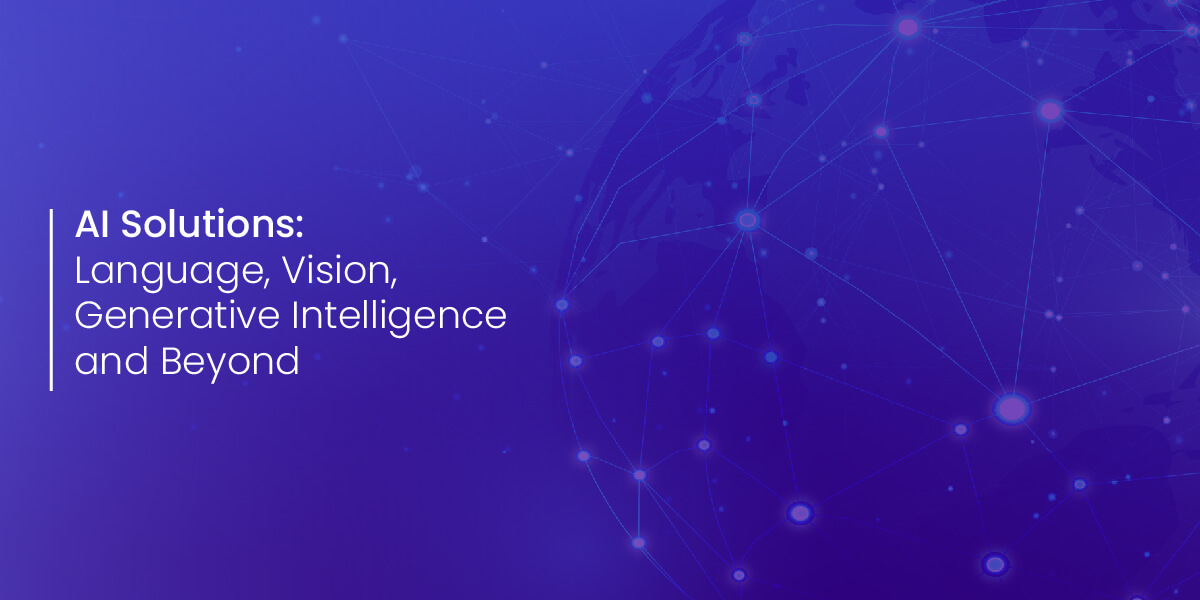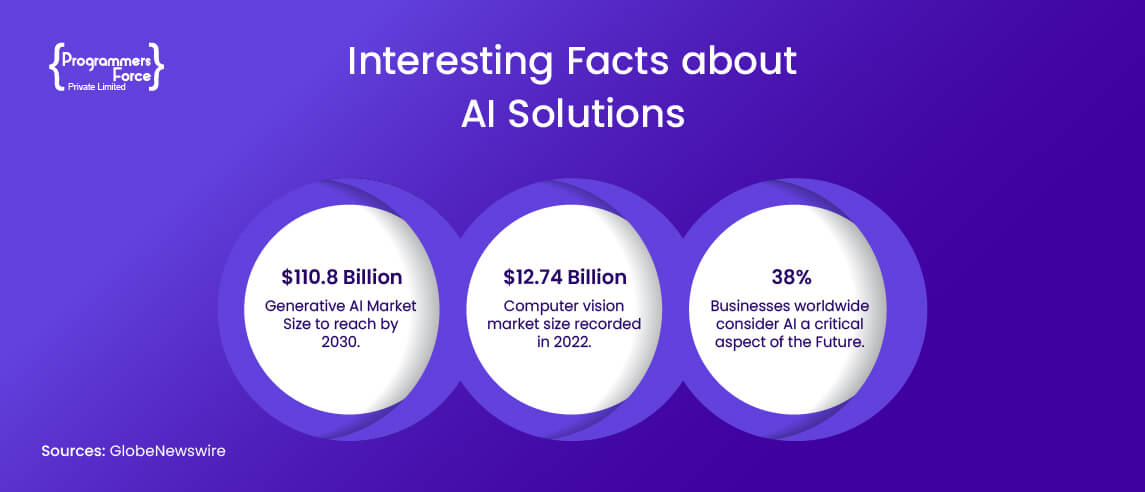
AI Solutions: Language, Vision, Generative Intelligence and Beyond
Technology is getting better with time, increasing the ability to help people better understand the world around them.
Over the past decade, technology has contributed a lot since the adoption of AI (Artificial Intelligence). These AI solutions tend to create more complex systems that understand and mimic human intelligence better, making overall efficiency increase.
For Instance, we are living in an age where AI can accomplish a variety of tasks, like creating music, drawing images from ideas, and making full-fledged videos and computer graphics.
Businesses are taking this approach to the next level as they aim to craft new solutions from this self-learning technology.
In 2022, the market revenue for AI solutions was recorded at $51.27 Billion and is predicted to touch $70 billion in 2023.
This blog covers the breathtaking advancements in the field of AI. Without further ado, let’s get started.
Language Models
Natural conversations are clearly the main focus of firms to derive an emergent way for people to interact with bots and computers.
Language processing is the most exciting area of artificial intelligence, especially machine learning. AI & Machine Learning works on different language models that provide important approaches to defining how the technology interprets different languages. Different strategies include sequence-to-sequence learning and development.
The language models are trained on fairly simple tasks such as predicting the next future text based on the input from the user. There are many different approaches developers use to train AI to provide correct feedback to the user. One of them is the Chain of Thought prompting method.
Chain of Thought Prompting
One of the challenges faced by AI developers when training the machine is to create a solution that performs multi-step reasoning when solving problems. Take an example of a simple math task that involves breaking down a task into several steps.
Combining those steps to form a logical solution, that addresses the main problem is the core work of Chain of Thought prompting.
It is the way of breaking down a problem to perform arithmetic, commonsense, and symbolic reasoning over it.
The model is encouraged to “Show its Work” in solving issues for instance:
“Steve has 5 cricket balls, he buys 2 more cans, each having 2 balls. How many cricket balls does Steve have now?”
The chain of thought prompting model will deconstruct the problem to provide the correct final answer, i.e.
- Steve started with 5,
- buys 2 cans again each having 2, 2+2 = 4
- The answer is 5+4 = 9
Computer Vision
It is the technology which works on the backend when deriving information from inputs such as images and videos. The recent developments in the field enable intelligent image processing to extract high-dimensional data that can be interpreted in the real world.
Many other technologies such as neural networks also play their part in enhancing computer vision models to understand all the information from the image input.
Intelligent Object Detection
AI is coming into power with new tools that enable the intelligent use of computer vision for accurate object detection. Pix2Seq is one of the modelling frameworks that tackle object detection in a completely different way. It casts the images and uses well-optimised pixel algorithms to achieve competitive results from an image. The model is pre-trained on large data sets to differentiate between different real-world objects. The model observes the pixels and reads out the locations and other attributes.
Neural Networks
The neural networks perceive the image attributes defined by the object detection model to generate a sequence of tokens (identification points) for each object in the image, corresponding to the bounding characteristics and class labels.
This artificial collection of neural nodes that acts as real human neurons defines the concept of artificial vision or giving a human-like sense to the computer.

Generative Models
When it comes to self-learning AI, the quality and capabilities of generative models are no exception. The generative models of imagery, video, and audio have truly shown stunning growth in the year 2022.
Many AI models introduced the power of generating a realistic output. A significant example of it is self-generating images just from text. For instance, the system takes just a text from the user to automatically put up the objects listed in the text forming an image which is real and contains all the elements mentioned.
Generative models use deep learning and generative algorithms to produce rich content.
Generative Audio and Video
Generating images is somewhat every modern AI-backed system can achieve with decent accuracy. The next step is producing high-quality and resolution video and audio with a consistent level of controllability.
This is a challenging area as videos are not static like images, the moving frames within the input make it competitive for the AI system to detect objects and generate a completely new output also in the form of moving images.
Phenaki is one of the realistic video generation solutions that use only textual description as the input. And when it comes to generative audio, AudioLM can provide rich sounds that promise long-term consistency.
AI Solutions: The Future?
The future of AI solutions is rich as the current advancements show a great rise and acceptance in this field. The introduction of different language models, one like ChatGPT, is making rounds on the internet. The more a model is trained, the higher the chances of a correct outcome.
Recent tech has inspired more researchers and firms to invest time and resources in the rapidly-growing field. We will see new trends in audio and video generative AI improving the phenomenon and providing limitless possibilities for improving creativity and innovation.
Final Thoughts
The year 2022, introduced an exciting advantage in the media lineup.
It improved the computers to interact with natural senses making them respond to voice (language and audio) and vision (images and videos) unlocking new ways of helping humans in creating innovative products that surpass the traditional tools.
Programmers Force is also contributing its part in devising solutions that make a positive difference in the modern world.






